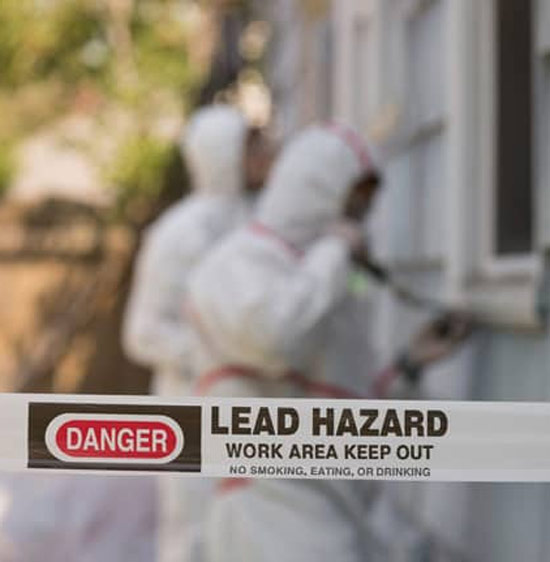Finest Practices for Ensuring Safe and Complete Lead Violation Abatement
Resolving lead violation reduction calls for a multi-faceted technique to make certain both safety and compliance. First assessments utilizing innovative detection techniques such as XRF analyzers established the phase for a precise understanding of contamination levels. Including correct containment methods, consisting of impermeable barriers and HEPA filtration, combined with the usage of individual protective equipment (PPE) for workers, develops the foundation of a safe and secure operation. Precise clean-up methods, including HEPA vacuuming and wet-wiping, are crucial. It's the last clearance procedure, entailing thorough inspections and laboratory testing, that truly confirms a lead-free environment, ensuring long-term safety. How do these practices adjoin to assure thorough lead reduction?

First Evaluation
Conducting a first evaluation is a crucial very first step in lead violation reduction. This phase incorporates a comprehensive evaluation of the building to determine the presence, degree, and specific areas of lead-based hazards. Certified professionals, such as qualified lead inspectors or take the chance of assessors, should do an extensive website inspection, using devices like X-ray fluorescence (XRF) analyzers to precisely identify and determine lead focus in paint, dust, soil, and water.
The analysis must likewise consist of a review of the structure's background, previous reports, and any type of issues or health problems reported by occupants - Lead Removal Contractors. Documenting the searchings for diligently is important, as these documents create the basis for developing an efficient reduction approach. A comprehensive evaluation also includes tasting and research laboratory evaluation, which are crucial to verify the visibility of lead and overview succeeding activities
Furthermore, it is crucial to connect the outcomes transparently to all stakeholders, including homeowner, occupants, and governing authorities. By guaranteeing that the preliminary evaluation is performed with precision and rigor, experts can lay a strong structure for a targeted and effective lead reduction process, eventually securing public health and wellness and making certain conformity with governing criteria.
Appropriate Control
Proper control is vital to avoid the spread of lead contaminants throughout abatement tasks. Successfully managing control reduces the risk of lead dirt and debris moving to non-work areas, therefore protecting both the environment and people outside the immediate job zone.

Regular examinations of the containment location are required to look for breaches or weak points in the barrier. Any type of identified problems should be immediately addressed to preserve the honesty of the containment. By sticking to these practices, abatement tasks can efficiently regulate lead contamination and mitigate connected health dangers.
Employee Protection
Guaranteeing employee protection is critical throughout lead reduction projects to avoid job-related exposure to harmful lead fragments. Important procedures consist of the usage of personal protective devices (PPE) such as respirators, handwear covers, and full-body matches specifically developed to obstruct lead dirt and fumes. Employees should undergo extensive training on the right use and upkeep of PPE, including fit testing for respirators to guarantee maximum effectiveness.
Design controls, such as neighborhood exhaust air flow systems, are crucial in reducing airborne lead concentrations in the workplace. Management controls should also be executed, including limiting the duration of exposure and rotating workers to reduce individual exposure times. Regular clinical security and organic surveillance are crucial for very early discovery of lead absorption, enabling timely treatment imp source and treatment.
Additionally, establishing a decontamination protocol is vital. Workers should follow stringent purification treatments prior to breaks and at the end of their shift to avoid lead dust from being lugged outside the workplace. This includes comprehensive hand and face washing with lead-specific cleansing representatives and changing out of contaminated apparel.
Thorough Clean-up
Preserving a safe workplace extends past employee protection and incorporates careful clean-up to ensure lead fragments are completely removed from the website. The process of meticulous cleaning is important in avoiding the recontamination of the abated location and protecting both existing and future passengers.
To achieve a thorough clean-up, all job areas have to be systematically sanitized. This includes using specialized HEPA (High-Efficiency Particulate Air) vacuum cleansers and wet-wiping techniques check out this site to record and remove great lead dust that may have chosen surfaces. It is essential to clean up all straight surfaces, consisting of floorings, window sills, and kitchen counters, as well as upright surface areas that may have caught lead fragments.
Workers need to put on suitable individual safety equipment (PPE) throughout cleaning to avoid exposure to recurring lead dirt. Used cleaning products such as wipes, sponges, and wipe heads should be thrown away based on hazardous waste disposal guidelines.

Last Clearance
Last clearance is the crucial concluding phase of lead abatement that determines whether check this site out the website is secure for reoccupation. This critical action entails thorough examination and screening to validate that all lead dangers have actually been successfully gotten rid of.

Last clearance screening not just safeguards future occupants yet additionally ensures conformity with regional, state, and federal laws. It offers as a documented recognition of the abatement service provider's adherence to market best methods. Guaranteeing a comprehensive and effective final clearance is crucial in securing public health and promoting rely on the reduction process.
Final Thought
Ensuring risk-free and thorough lead infraction reduction requires a complex method incorporating initial evaluations with innovative detection techniques, effective containment methods, stringent worker defense protocols, and precise cleaning procedures. The final clearance phase, including detailed evaluations and research laboratory screening, is important to validate conformity with EPA standards. Adherence to these finest methods assures a safe environment for passengers, minimizes health risks, and supports regulative needs, therefore promoting public health and security in lead-affected areas.
Comments on “NYC Lead Removal Contractors-- Get Safe and Reliable Providers”